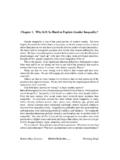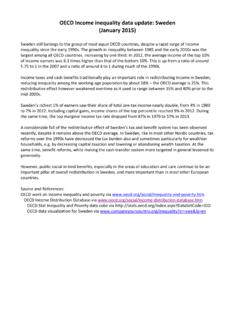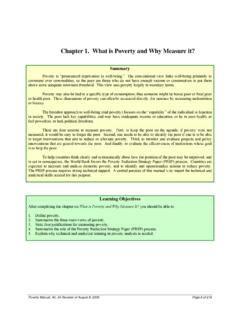Transcription of Gender inequality: Empowering women - AABRI
1 Journal of Legal Issues and Cases in Business Gender inequality , page 1 Gender inequality : Empowering women Cheryl Lynn Kelsey Texas A&M University-San Antonio ABSTRACT Numerous court rulings and Gender discrimination laws have legitimized a women s right to equality and yet subtle sexist behaviors remind females that they are not truly equal in the workplace. These discriminatory practices are being legally challenged by women committed to attaining full equality and changing the inequities of employment compensation and benefits. Employment discrimination is considered to be unlawful when adverse treatment of employees is motivated by age, sex, race, creed, religion, national origin, disability, veterans status or other protected class status (Civil Rights Act of 1964). ). Gender discrimination laws apply to both men and women equally but women are often the victim (Gregory, 2003).
2 Although women have yet to be the victor in attaining full equality, this article will examine the current under-payment of women and the employment discrimination laws that have been passed so that no Gender need be the victim of a sexist economy. Keywords: Pay Gap, Economic Discrimination, Gender Discrimination Laws Copyright statement: Authors retain the copyright to the manuscripts published in AABRI journals. Please see the AABRI Copyright Policy at Journal of Legal Issues and Cases in Business Gender inequality , page 2 INTRODUCTION This article will examine Gender inequality , specifically economic discrimination and females. Numerous court rulings and Gender discrimination laws have legitimized a women s right to equality and yet subtle sexist behaviors remind females that they are not truly equal in the workplace. These discriminatory practices are being legally challenged by women committed to attaining full equality and changing the inequities of employment compensation and benefits.
3 Employment discrimination is considered to be unlawful when adverse treatment of employees is motivated by age, sex, race, creed, religion, national origin, disability, veterans status or other protected class status (Civil Rights Act of 1964). Gender discrimination, Gender bias, or the less commonly used term, sexual discrimination, is a form of employment discrimination whereby employees are treated differently based on the person s Gender . It is illegal for employers to discriminate against any employee, or applicant for employment, because of his or her sex in connection with hiring, termination, promotion, demotion, compensation, job training, job placement, discipline or any other term, condition, or privilege of employment (Equal Pay Act of 1963). Gender discrimination laws apply to both men and women equally but women are often the victim (Gregory, 2003). Although women have yet to be the victor in attaining full equality, this article will examine the current under-payment of women and the employment discrimination laws that have been passed so that no Gender need be the victim of a sexist economy.
4 ECONOMIC DISCRIMINATION Gender pay gap, Gender wage gap, male-female income difference, and Gender earnings gap are various terms used to describe the statistical difference in the average yearly income between males and females. The difference is measured as the ratio of female to male median yearly earnings among full-time, year-round workers. The female-to-male median yearly earnings ratio was in 2011, meaning females earned 77 percent of what their male counterparts were paid, a gap of 23 percent ( Census Bureau, 2012). This ratio is calculated annually and is based on data obtained by the Bureau of Labor Statistics Current Population Survey on the median annual earnings of all men and women classified as full time workers ( ). In 2011, the median annual earnings of women and men who worked full time, year-round was $37,118 and $48,202 respectively ( Census Bureau, 2012).
5 According to a Bureau of Labor Statistics Report (2013), the female-to-male median usual weekly earnings ratio was in 2011. This ratio is based on women employed full time in wage and salary jobs having a median usual weekly earnings of $ compared to men with a median usual weekly earnings of $ ( Bureau of Labor Statistics, 2013). Females in 2011 earned 82 percent of the medium usual weekly earnings of what their male counterparts were paid, a gap of 18 percent. The Gender pay gap has been described as an untrue feminist notion that does not take in account factors other than wage discrimination. According to this theory, women make less money because of the choices they make such as less education, lower-paying occupations, and prioritizing the responsibilities of being a mother (Farrell, 2005). This analogy can be compared to deciding which dog, even though they are the same height and weight, receives more food.
6 One dog is brown with touches of white on her ears, enjoys walking with his owner, does not bark at visitors, and recently delivered three puppies. Another dog has white fur, has learned to Journal of Legal Issues and Cases in Business Gender inequality , page 3 sit and roll over on command, guards the house day and night by barking, and has recently been spade. The logic according to this theory is that the second dog needs more food because he has made better choices. He knows how to sit and roll over (more education), can guard the house (higher paid occupation than walking with the owner), and is more focused on his owner (no pesky puppies to feed). The same mistaken logic of blaming women for the choices they have made is used to explain why women make less money than men. Existing cultural biases deny both males and females equal opportunities in the workplace. Cultural bias has been attributed to experimental research in which equivalence between males and females was established (Foshi, 2000).
7 Studies show that when women violate traditional Gender norms by demonstrating to be competent leaders, evaluators perceived them to be less likeable and less likely to be recommended for hiring or promotion (Eagly & Karau, 2002; Heilman, Wallen, Fuchs, and Tamkins, 2004). According to Reskin (2000), women and minorities were more likely to be hired when Gender is unknown in the selection process. The number of women and minorities hired by the Civil Service increased significantly when job applicants were no longer required to include photographs (Rosenbloom, 1977). When symphony orchestras adopted blind auditions by using a screen to conceal candidates identities, the hiring of women musicians increased (Goldin & Rouse, 2000). women were more likely to be hired when a computerized application process was used where Gender was not identified (Guinier & Sturm, 2001). Williams and Bornstein (2008) identified three major sources of bias in the evaluation of women compared to men.
8 First, women are judged by stricter standards than men making it more difficult for them to appear competent. Second, men have to give a convincing demonstration of incompetency to be actually judged incompetent. Third, men tend to be judged on their potential for accomplishment, whereas women are judged on what they have already accomplished. The Gender pay gap affects all women regardless of their backgrounds, ages, and education. women earn less than men even though women are becoming slightly more educated than men. Between 1970 and 2012, the percentage of women with a high school education increased from 55% to 88% (National Center for Education Statistics, 2012). During the same time, the percentage of men with a high school education increased from 55% to 87% (National Center for Education Statistics, 2012). In 2012, 38% of the females and 31% of the males held a bachelor s degree (National Center for Education Statistics, 2012).
9 Regardless of this increase by women in educational attainment, the pay gap is evident at every level of academic achievement. According to Corbett and Hill (2012) women , one year out of college working full time, earned $35,296 compared to $42,918 earned by men that were one year out of college and working full time. The median yearly earnings for women are lower than men s in nearly all occupations, including those that predominantly employ men, women , or an even mix of men and women ( Bureau of Labor Statistics, 2013). According to the Institute for women 's Policy Research (2011), out of the 111 occupations that the Bureau of Labor Statistics estimates median weekly earnings, women make less money in 107 of those occupations. In an executive summary by Carnevale, Rose and Cheah (2011), sponsored by Georgetown University, Center on Education and the Workforce, race, ethnicity and Gender are wild cards that matter more than education or occupation in determining earnings (p.)
10 1). Male dominated occupations have higher median earnings than female dominated occupations. Three times as many women ( million) than men ( million) work in occupations that pay below the federal poverty threshold for a family of four (Institute for Journal of Legal Issues and Cases in Business Gender inequality , page 4 women s Policy Research, 2011). Occupations such as teaching, counseling, nursing, and social work are referred to as pink-collared jobs and tend to have lower wages. Even when women work in traditional male occupations such as engineering, they still face a pay gap when compared to their male counterparts. Earnings are not only affected by Gender , but also by races and ethnicities. Within racial or ethnic groups, Hispanic, Latina, and African American women had lower median weekly earnings compared with white and Asian American women (American Association of University women , 2013).















